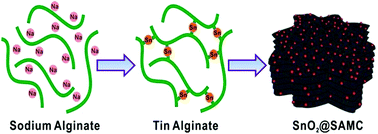In situ preparation of uniform and ultrafine SnO2 nanocrystals anchored within a mesoporous carbon network as advanced anode materials†
Abstract
The creation of a cooperative effect between zero-dimensional (0D) SnO2 particles and carbonaceous materials with space-confined structures has shown great potential in achieving advanced lithium-ion battery anodes (LIBs), but is full of challenges. Herein, we report a novel and green approach for the preparation of uniform SnO2 nanocrystals anchored within a continuous mesoporous carbon network. For the first time, the formation of SnO2 nanocrystals and in situ carbon-coating were achieved simultaneously through the ion exchange and hydrothermal method (IEHM), and the subsequent calcination further endows the composites with a robust 3D-interconnected porous structure. The resulting product consists of SnO2 nanocrystals with a uniform size (2.2–3.8 nm) and continuous mesoporous carbon network, which exhibits a large surface area (257 m2 g−1) and a high content of SnO2 (∼70 wt%). As a result, the as-prepared SnO2/C nanocomposites showed a high reversible capacity of 1024.6 mA h g−1 at 200 mA g−1 even after 300 cycles as an anode material for LIBs. Moreover, the facile preparation of uniform SnO2 nanocrystals by the IEHM would be helpful in promoting nanostructure engineering of other metal oxide materials.



 Please wait while we load your content...
Please wait while we load your content...